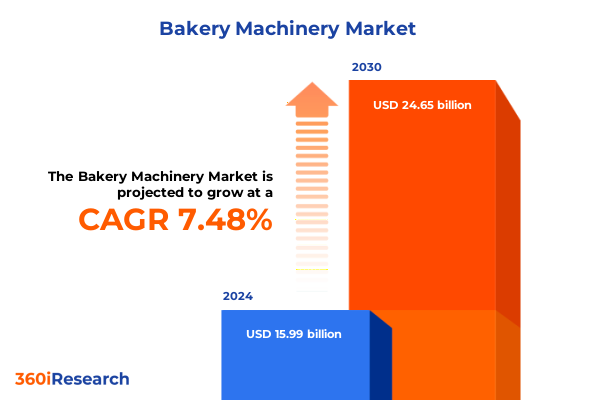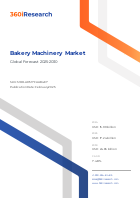The Bakery Machinery Market size was estimated at USD 15.99 billion in 2024 and expected to reach USD 17.24 billion in 2025, at a CAGR 7.48% to reach USD 24.65 billion by 2030.

Introduction to the Evolving Bakery Machinery Ecosystem
The bakery machinery sector is experiencing a period of unprecedented evolution driven by rapid technological innovation, shifting consumer preferences, and a greater emphasis on operational efficiency. Rising demand for artisan and specialty products has fueled investments in advanced mixing, dividing, proofing, and baking equipment capable of delivering consistent quality at scale. Simultaneously, automation and robotics are transforming production lines, enabling manufacturers to achieve higher throughput with reduced labor costs and minimal downtime. Sustainability considerations have also gained prominence, with energy-efficient ovens and multifunctional machines at the forefront of capital expenditure decisions. As regulatory landscapes evolve and global trade dynamics shift, industry stakeholders must remain agile and informed to capitalize on emerging opportunities. This executive summary provides a concise yet comprehensive overview of the key market drivers, transformative shifts, regulatory impacts, segmentation insights, regional dynamics, competitive intensity, and strategic imperatives shaping the future of bakery machinery.
Transformative Shifts Reshaping the Bakery Machinery Landscape
Over the past few years, the bakery machinery landscape has undergone transformative shifts that extend far beyond incremental upgrades. First and foremost, Industry 4.0 solutions have embedded cloud connectivity, data analytics, and remote monitoring into core production assets, allowing operators to predict maintenance needs and optimize throughput in real time. In parallel, the integration of collaborative robots has reduced repetitive manual tasks such as dough dividing and slicing, freeing skilled bakers to focus on product innovation and quality assurance. Sustainability agendas have also driven the adoption of energy recovery systems in ovens, as well as hybrid power sources that balance electric and gas consumption. Meanwhile, emerging markets are embracing compact, semi-automatic lines that cater to boutique producers, further diversifying the competitive landscape. Taken together, these shifts underscore a broader trend toward intelligent, connected, and eco-conscious machinery that delivers both operational resilience and strategic differentiation.
Assessing the Cumulative Impact of 2025 US Tariffs on Bakery Machinery
In 2025, the United States enacted a series of tariffs targeting imported bakery machinery components and finished units, reflecting broader trade tensions and domestic industrial policy objectives. These measures have exerted upward pressure on input costs, particularly for manufacturers reliant on specialized mixers, proofers, and baking tunnels sourced from overseas suppliers. As a result, some domestic producers have accelerated localization efforts, forging partnerships with component manufacturers to mitigate exposure to tariff volatility. At the same time, global OEMs are reevaluating supply chains, shifting production lines closer to end markets or exploring alternate sourcing within tariff-exempt regions. The consolidated impact has been twofold: price escalation for end-users in both commercial and industrial segments, and an increased impetus for design modularity to facilitate component substitution. Collectively, these factors have underscored the strategic importance of supply chain agility and have prompted manufacturers to reexamine long-term sourcing models in the face of sustained trade uncertainty.
Key Segmentation Insights: Machine Types, Automation, End-User, Functionality, Energy, Products, Maintenance
The bakery machinery market can be deconstructed across seven critical segmentation pillars, each revealing unique growth vectors and investment priorities. Machine Type encompasses Divider offerings, which include specialized Dough Dividers and high-capacity Multidividers, alongside Mixer variants such as Horizontal, Planetary, and Spiral models; oven solutions ranging from Convection to Deck and Tunnel configurations; proofing systems available in Box and Rack formats; sheeters configured as floor-mounted or tabletop units; and slicers engineered for bench or countertop deployment. Automation Level differentiates fully automated lines and robotic integration options from semi-automatic setups optimized for batch operations or continuous workflows. End-User Industry captures demand from artisan bakers operating boutique and independent outlets, food service operators in catering, hospitality, and restaurant sectors, large-scale contract and mass production facilities, and retail bakery formats within convenience and supermarket chains. Functionality spans core baking processes-such as steam and stone baking-alongside cooling and freezing solutions that utilize ambient or blast techniques, glazing and icing systems offering sheet and spot applications, and mixing platforms engineered for high- or low-speed performance. Energy Source segmentation contrasts electrically powered machinery, available in single-phase and three-phase variants, with gas-powered options fueled by LPG or natural gas. Bakery Product focus highlights equipment tailored for bread and rolls- including multigrain and sourdough lines-cakes and pastries such as cupcakes and layer cakes, and cookies and biscuits distinguished by crunchy or soft-textured outcomes. Finally, Maintenance Requirements distinguish manual cleaning protocols involving dismantling and external service options from self-cleaning architectures utilizing air filtration or water-based systems. Together, these segmentation insights illuminate where capital investment intersects with operational priorities, guiding manufacturers and end-users toward the configurations that best align with production scale, product diversity, and cost-efficiency targets.
This comprehensive research report categorizes the Bakery Machinery market into clearly defined segments, providing a detailed analysis of emerging trends and precise revenue forecasts to support strategic decision-making.
- Machine Type
- Automation Level
- End-User Industry
- Functionality
- Energy Source
- Bakery Product
- Maintenance Requirements
Key Regional Insights: Americas, EMEA, Asia-Pacific Dynamics
Regional dynamics in bakery machinery reveal distinct growth drivers and market maturities. In the Americas, advanced economies continue to invest in high-capacity ovens and fully automated dividing and slicing solutions to meet escalating demand for premium bread and on-the-go snacks. North American manufacturers are also pioneering energy-efficient retrofits and modular line expansions. In Latin America, emerging urbanization and expanding quick-service restaurant chains are catalyzing demand for semi-automatic mixers and proofers that balance cost and performance. Across Europe, Middle East & Africa, stringent food safety regulations and sustainability mandates have elevated interest in self-cleaning and environmentally optimized freezing and cooling units, while artisan bakery culture sustains demand for specialized steam and stone ovens. Regional alliances and free-trade agreements further shape supply routes, prompting OEMs to tailor their portfolios accordingly. Meanwhile, Asia-Pacific markets, led by urban centers in China, India, and Southeast Asia, are rapidly adopting mid-tier automation with robotic slicing and high-speed mixing to satisfy a growing consumer palate for packaged baked goods. Infrastructure investments in cold chain logistics enhance the appeal of blast freezing solutions. Collectively, these regional patterns underscore the necessity for market participants to tailor strategies to local regulatory frameworks, channel structures, and consumption trends.
This comprehensive research report examines key regions that drive the evolution of the Bakery Machinery market, offering deep insights into regional trends, growth factors, and industry developments that are influencing market performance.
- Americas
- Asia-Pacific
- Europe, Middle East & Africa
Competitive Intelligence: Leading Bakery Machinery Companies
Competitive intensity in bakery machinery is concentrated among a group of established global and regional players, each pursuing differentiated strategies to capture market share. Ali Holding S.R.L. and Allied Bakery Equipment emphasize custom engineering and aftermarket service networks to build customer loyalty, while Anko Food Machine Co., Ltd. focuses on cost-competitive solutions for mid-market producers. Baker Perkins Limited and the Bühler Group leverage extensive R&D investments to introduce smart ovens and digital twins that optimize thermal profiles. Erika Record Baking Equipment and GEA Group Aktiengesellschaft prioritize turnkey line delivery, integrating proofers, sheeters, and slicers into cohesive platforms. Gemini Bakery Equipment and Global Bakery Solutions excel in modular designs that accommodate shifting product mixes, whereas Heat and Control Inc. and JBT Corporation capitalize on process automation and hygiene-focused innovations. Kar Bakery Equipment’s India Pvt. Ltd and Koenig Group Baking Equipment harness local manufacturing efficiencies to serve high-growth Asian markets, and Rheon Automatic Machinery Co. Ltd. targets specialized applications in glaze and icing systems. Finally, The Middleby Corporation is expanding its footprint via strategic acquisitions, adding robotics and digital services to its portfolio. This landscape of diversified strategies-ranging from service differentiation and localization to technology leadership and M&A-reflects the intense push for operational excellence and long-term customer value.
This comprehensive research report delivers an in-depth overview of the principal market players in the Bakery Machinery market, evaluating their market share, strategic initiatives, and competitive positioning to illuminate the factors shaping the competitive landscape.
- Ali Holding S.R.L.
- Allied Bakery Equipment
- Anko Food Machine co., ltd.
- Baker Perkins Limited
- Bühler Group
- Erika Record Baking Equipment
- GEA Group Aktiengesellschaft
- Gemini Bakery Equipment
- Global Bakery Solutions
- Heat and Control Inc.
- JBT Corporation
- Kar Bakery Equipment’s India Pvt. Ltd
- Koenig Group Baking Equipment
- Rheon Automatic Machinery co. ltd.
- The Middleby Corporation
Actionable Recommendations for Industry Leaders
Industry leaders must adopt a multi-pronged approach to drive sustainable growth and resilience. Prioritize the integration of IIoT platforms across legacy and new assets to enable predictive maintenance and real-time production analytics, maximizing uptime and quality control. Invest in modular design principles to facilitate rapid reconfiguration of lines in response to evolving product trends and tariff fluctuations, thus preserving profitability during supply chain disruptions. Expand aftermarket service offerings, including remote diagnostics and performance-based service agreements, to lock in recurring revenue and deepen customer relationships. Elevate sustainability credentials by adopting waste heat recovery systems in ovens and exploring hybrid energy sources that align with corporate net-zero targets. Foster strategic partnerships with robotics specialists and software providers to embed automation at critical junctures-such as dough handling and slicing-boosting throughput while reducing labor overhead. Finally, develop region-specific go-to-market models that leverage local manufacturing, distribution, and regulatory ecosystems to optimize cost structures and expedite time-to-market.
Explore AI-driven insights for the Bakery Machinery market with ResearchAI on our online platform, providing deeper, data-backed market analysis.
Ask ResearchAI anything
World's First Innovative Al for Market Research
Conclusion: Navigating the Future of Bakery Machinery
The bakery machinery market is at the intersection of technology, regulation, and consumer-driven innovation. As tariff regimes and regional policies reshape supply chains, manufacturers must strike a delicate balance between global sourcing and local agility. Integrated automation, modular configurations, and energy-efficient designs will be the hallmarks of competitive advantage, while aftermarket services and digital platforms will underpin customer retention strategies. Moreover, nuanced understanding of regional dynamics and targeted product portfolios will enable players to capture value across a diverse set of end-user segments, from artisan bakers to industrial-scale producers. By aligning R&D priorities with emerging consumption patterns and sustainability imperatives, equipment suppliers can secure their leadership positions in an evolving landscape defined by both complexity and opportunity.
This section provides a structured overview of the report, outlining key chapters and topics covered for easy reference in our Bakery Machinery market comprehensive research report.
- Preface
- Research Methodology
- Executive Summary
- Market Overview
- Market Dynamics
- Market Insights
- Cumulative Impact of United States Tariffs 2025
- Bakery Machinery Market, by Machine Type
- Bakery Machinery Market, by Automation Level
- Bakery Machinery Market, by End-User Industry
- Bakery Machinery Market, by Functionality
- Bakery Machinery Market, by Energy Source
- Bakery Machinery Market, by Bakery Product
- Bakery Machinery Market, by Maintenance Requirements
- Americas Bakery Machinery Market
- Asia-Pacific Bakery Machinery Market
- Europe, Middle East & Africa Bakery Machinery Market
- Competitive Landscape
- ResearchAI
- ResearchStatistics
- ResearchContacts
- ResearchArticles
- Appendix
- List of Figures [Total: 30]
- List of Tables [Total: 1343 ]
Contact Ketan Rohom for Exclusive Market Research Access
To gain in-depth access to comprehensive market research, reach out directly to Ketan Rohom (Associate Director, Sales & Marketing at 360iResearch).

- How big is the Bakery Machinery Market?
- What is the Bakery Machinery Market growth?
- When do I get the report?
- In what format does this report get delivered to me?
- How long has 360iResearch been around?
- What if I have a question about your reports?
- Can I share this report with my team?
- Can I use your research in my presentation?




